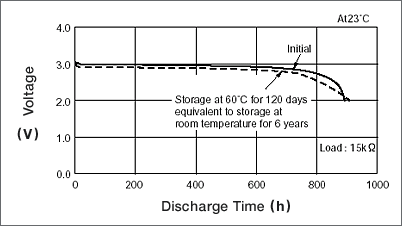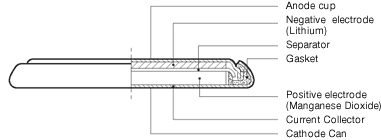Murata Coin Manganese Dioxide Lithium Batteries Introduction
Introduction
Coin Manganese Dioxide Lithium Batteries are being used in a broad range of applications, from quarts watches and clocks, a backup power sources for memories requiring long-term reliability over 10 years to IoT equipment, and car keyless entry systems. Lithium metal, used for the anode in Coin Manganese Dioxide Lithium Batteries, has the largest electric capacity per unit weight (3.86 Ah/g) among all the materials usable for the anode. Thus, batteries with a high energy density can be produced. Also, by using different active materials for the cathode, batteries with diverse characteristics can be made. Murata has commercialized the Coin Manganese Dioxide Lithium Batteries, which uses manganese dioxide for the active cathode material for superior stability.
 Lightweight, High Voltage and High Energy Density
Lightweight, High Voltage and High Energy Density- The battery voltage is 3V, almost double that of normal alkaline or manganese batteries. This means that the number of batteries required for equipment can be halved for maximum space saving and weight reduction.
 Excellent Discharge Characteristics
Excellent Discharge Characteristics- Voltage characteristics remain stable even for a long period of discharge, greatly improving the reliability of equipment that uses the battery. Such equipment is also maintenance-free (battery replacement is seldom required).
 Outstanding Temperature Characteristics
Outstanding Temperature Characteristics- Murata's original organic electrolyte provides superb characteristics over a wide range of temperature from low to high.
• -30 to +70 degrees C  Excellent Leakage Resistance
Excellent Leakage Resistance- The newly developed battery construction and electrolyte ensure maximum leakage resistance over a long span of time.
 Excellent Long-Term Reliability
Excellent Long-Term Reliability- Carefully selected active materials are used for the active material as well as for the electrolyte. These materials are sealed by Murata's innovative technology to minimize battery self-discharge. The annual self-discharge rate at room temperature and normal humidity is less than 1% of the nominal capacity.
Specially processed manganese dioxide (MnO2) is used for the active cathode material, and high-voltage, high-activity lithium metal for the active anode material. The electrolyte is lithium salt molten into an organic solution to ensure easy transmission of high voltage and high energy to the exterior.
Battery discharge reactions are as follows:

With open circuit voltage of approx. 3V, the battery voltage is extremely stable and impedance remains low and stable during discharge.

 Storage at 60°Cfor 120 days is the equivalent of storage at room temperature for 6 years.
Storage at 60°Cfor 120 days is the equivalent of storage at room temperature for 6 years. Excellent long-term storage reliability.
Excellent long-term storage reliability. After storage, discharge voltage/discharge time show little decrease and are stable.
After storage, discharge voltage/discharge time show little decrease and are stable.




